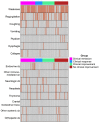Clinical features and outcome of acquired myasthenia gravis in 94 dogs
- PMID: 34331481
- PMCID: PMC8478050
- DOI: 10.1111/jvim.16223
Clinical features and outcome of acquired myasthenia gravis in 94 dogs
Abstract
Background: Factors known to be associated with outcome of acquired myasthenia gravis (MG) in dogs are limited.
Hypothesis/objectives: Of dogs with MG, advancing age and comorbid neoplasia are associated with poor long-term prognosis and low rates of remission.
Animals: Ninety-four client-owned dogs with MG diagnosed by acetylcholine receptor antibody (AChR Ab) assay between 2001 and 2019 from a university clinic and 3 private clinics in the United States.
Methods: Cases were retrospectively evaluated and data were collected to determine clinical signs, treatment, and response to therapy defined by means of a clinical scoring rubric. Immunological remission was defined as a return of the AChR Ab concentration to <0.6 nmol/L. Multivariable binary logistic regression analysis was used to identify clinical criteria predicting remission.
Results: An anticholinesterase drug was used to treat 90/94 (96%) dogs, which in 63/94 (67%) was the sole treatment; other drugs included immune modulators. Clinical remission (lack of clinical signs ≥4 weeks after treatment cessation) was observed in 29 (31% [95% confidence interval (CI): 22.4-40.8%]) dogs, clinical response (lack of clinical signs on treatment) in 14 (15% [95% CI: 9.0-23.6%]) dogs, clinical improvement (on treatment) in 24 (26% [95% CI: 17.8-35.2%]) dogs, and no clinical improvement in 27 (29% [95% CI: 20.5-38.6%]) dogs. Immunological remission was observed in 27/46 (59%) dogs, with clinical remission in all 27. Younger age (P = .04) and comorbid endocrine disease (P = .04) were associated with clinical remission. Initial AChR Ab concentration (P = .02) and regurgitation (P = .04) were negatively associated with clinical remission.
Conclusions and clinical importance: Clinical remission in MG is less likely in older dogs and dogs presenting with regurgitation or high initial AChR Ab concentration, but more likely in younger dogs and dogs with comorbid endocrine disease.
Keywords: acetylcholine; autoimmune; comorbidity; junctionopathy; prognosis; remission.
© 2021 The Authors. Journal of Veterinary Internal Medicine published by Wiley Periodicals LLC on behalf of American College of Veterinary Internal Medicine.
Conflict of interest statement
Authors declare no conflict of interest.
Figures





Similar articles
-
Antibody to acetylcholine receptor in canine and human myasthenia gravis: differential cross-reactivity with human and rabbit receptor.Neurology. 1979 Jul;29(7):1065-8. doi: 10.1212/wnl.29.7.1065. Neurology. 1979. PMID: 572937
-
Spontaneous remission in canine myasthenia gravis: implications for assessing human MG therapies.Neurology. 2001 Dec 11;57(11):2139-41. doi: 10.1212/wnl.57.11.2139. Neurology. 2001. PMID: 11739846
-
Correlation of anti-acetylcholine receptor antibody levels and long-term outcomes of juvenile myasthenia gravis in Taiwan: a case control study.BMC Neurol. 2019 Jul 18;19(1):170. doi: 10.1186/s12883-019-1397-0. BMC Neurol. 2019. PMID: 31319795 Free PMC article.
-
Acquired myasthenia gravis: what we have learned from experimental and spontaneous animal models.Vet Immunol Immunopathol. 1999 Aug 2;69(2-4):239-49. doi: 10.1016/s0165-2427(99)00058-6. Vet Immunol Immunopathol. 1999. PMID: 10507309 Review.
-
[Antibodies in myasthenia gravis].Rev Neurol (Paris). 2009 Feb;165(2):137-43. doi: 10.1016/j.neurol.2008.11.020. Epub 2009 Jan 21. Rev Neurol (Paris). 2009. PMID: 19162288 Review. French.
Cited by
-
Seronegative Myasthenia Gravis with Concomitant SARS-CoV-2 Infection in a Dog.Vet Sci. 2022 Jun 24;9(7):318. doi: 10.3390/vetsci9070318. Vet Sci. 2022. PMID: 35878335 Free PMC article.
-
Acquired Myasthenia Gravis in a Juvenile Australian Shepherd Dog and Efficacy of Leflunomide Treatment.Case Rep Vet Med. 2025 Aug 13;2025:1607891. doi: 10.1155/crve/1607891. eCollection 2025. Case Rep Vet Med. 2025. PMID: 40843319 Free PMC article.
-
Successful Emergency Management of a Dog with Ventilator-Dependent Acquired Myasthenia Gravis with Immunoadsorption.Animals (Basel). 2023 Dec 21;14(1):33. doi: 10.3390/ani14010033. Animals (Basel). 2023. PMID: 38200764 Free PMC article.
-
Preoperative management and postoperative complications in 9 dogs undergoing surgical treatment of thymic-associated myasthenia gravis.Can Vet J. 2024 Jul;65(7):682-691. Can Vet J. 2024. PMID: 38952759 Free PMC article.
-
Case report: Immune remission from generalized myasthenia gravis in a dog with a thymoma and cholangiocellular carcinoma.Front Vet Sci. 2023 Mar 17;10:1124702. doi: 10.3389/fvets.2023.1124702. eCollection 2023. Front Vet Sci. 2023. PMID: 37008354 Free PMC article.
References
-
- Shelton GD. Acquired myasthenia gravis: what we have learned from experimental and spontaneous animal models. Vet Immunol Immunopathol. 1999;69(2):239‐249. - PubMed
-
- Shelton GD. Myasthenia gravis and congenital myasthenic syndromes in dogs and cats: a history and mini‐review. Neuromuscul Disord NMD. 2016;26(6):331‐334. - PubMed
-
- Shelton GD, Cardinet GH, Lindstrom JM. Canine and human myasthenia gravis autoantibodies recognize similar regions on the acetylcholine receptor. Neurology. 1988;38(9):1417‐1423. - PubMed
MeSH terms
Substances
LinkOut - more resources
Full Text Sources
Medical

